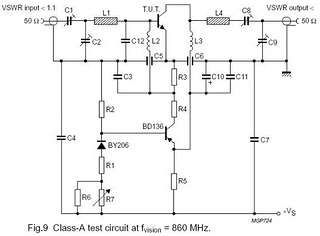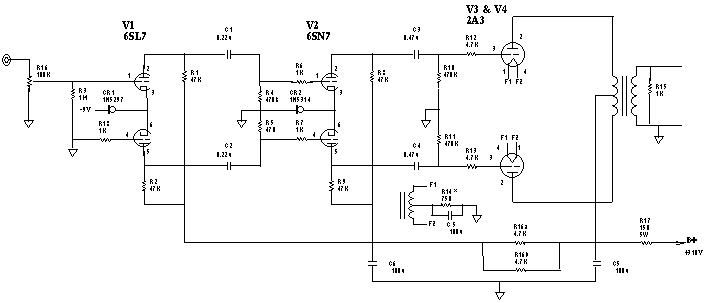
LM2876 amplifier configuration

A single power amplifier circuit using the LM2876 IC is designed. An external transistor (VTf) is configured to form an emitter follower, which provides a neutral level (7 feet) for the LM2876, ensuring reliable noise suppression in the circuit along with the associated bias circuitry. A mute switch (SA) is included, as well as a potentiometer (RP) for volume control. Capacitor C4, with a capacitance value of 7 feet, is connected to the AC ground, serving to enhance the common mode rejection ratio of the amplifier and ultimately improve sound quality.
The LM2876 power amplifier circuit is a robust design intended for audio applications, featuring an integrated circuit that simplifies the amplification process while ensuring high fidelity. The use of an external transistor configured as an emitter follower allows for a stable output level, which is essential for maintaining audio quality. This configuration also aids in minimizing distortion and enhancing the linearity of the amplifier's response.
The mute switch (SA) is strategically placed within the circuit to allow for quick disengagement of the amplifier output, providing a means to silence the audio without altering the gain settings. This feature is particularly beneficial in scenarios where immediate silence is required, such as during interruptions or transitions between audio sources.
The potentiometer (RP) serves as a variable resistor, allowing the user to adjust the volume of the audio output. This component is critical for user interaction, providing a simple yet effective means to control sound levels according to the listener's preference.
Capacitor C4 plays a significant role in the overall performance of the amplifier. By connecting it to the AC ground, it acts as a filter that improves the common mode rejection ratio (CMRR). A higher CMRR indicates better performance in rejecting noise that may affect the audio signal, leading to clearer sound reproduction. The choice of a 7-foot capacitance value is specifically aimed at optimizing the frequency response and enhancing the amplifier's ability to handle various audio signals without introducing unwanted artifacts.
In summary, this power amplifier circuit design effectively integrates various components to ensure high-quality audio output while providing user-friendly features such as volume control and a mute function. The careful selection of components and their configuration is crucial for achieving optimal performance in audio applications.A single power amplifier circuit LM2876 crrL constituted. VTf external transistor to form the emitter type to provide neutral level (7 feet) for the LM2876, guaranteed lC relia ble noise suppression circuit and associated circuitry bias. Mute switch button switch SA. Potentiometer RP for the volume control. Capacitor C4 is 7 foot AC ground capacitance, the purpose is to improve the common mode rejection ratio of the amplifier, power amplifier to improve sound quality.
The LM2876 power amplifier circuit is a robust design intended for audio applications, featuring an integrated circuit that simplifies the amplification process while ensuring high fidelity. The use of an external transistor configured as an emitter follower allows for a stable output level, which is essential for maintaining audio quality. This configuration also aids in minimizing distortion and enhancing the linearity of the amplifier's response.
The mute switch (SA) is strategically placed within the circuit to allow for quick disengagement of the amplifier output, providing a means to silence the audio without altering the gain settings. This feature is particularly beneficial in scenarios where immediate silence is required, such as during interruptions or transitions between audio sources.
The potentiometer (RP) serves as a variable resistor, allowing the user to adjust the volume of the audio output. This component is critical for user interaction, providing a simple yet effective means to control sound levels according to the listener's preference.
Capacitor C4 plays a significant role in the overall performance of the amplifier. By connecting it to the AC ground, it acts as a filter that improves the common mode rejection ratio (CMRR). A higher CMRR indicates better performance in rejecting noise that may affect the audio signal, leading to clearer sound reproduction. The choice of a 7-foot capacitance value is specifically aimed at optimizing the frequency response and enhancing the amplifier's ability to handle various audio signals without introducing unwanted artifacts.
In summary, this power amplifier circuit design effectively integrates various components to ensure high-quality audio output while providing user-friendly features such as volume control and a mute function. The careful selection of components and their configuration is crucial for achieving optimal performance in audio applications.A single power amplifier circuit LM2876 crrL constituted. VTf external transistor to form the emitter type to provide neutral level (7 feet) for the LM2876, guaranteed lC relia ble noise suppression circuit and associated circuitry bias. Mute switch button switch SA. Potentiometer RP for the volume control. Capacitor C4 is 7 foot AC ground capacitance, the purpose is to improve the common mode rejection ratio of the amplifier, power amplifier to improve sound quality.





